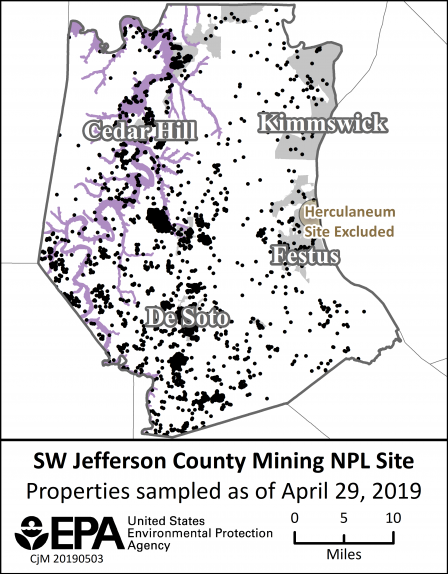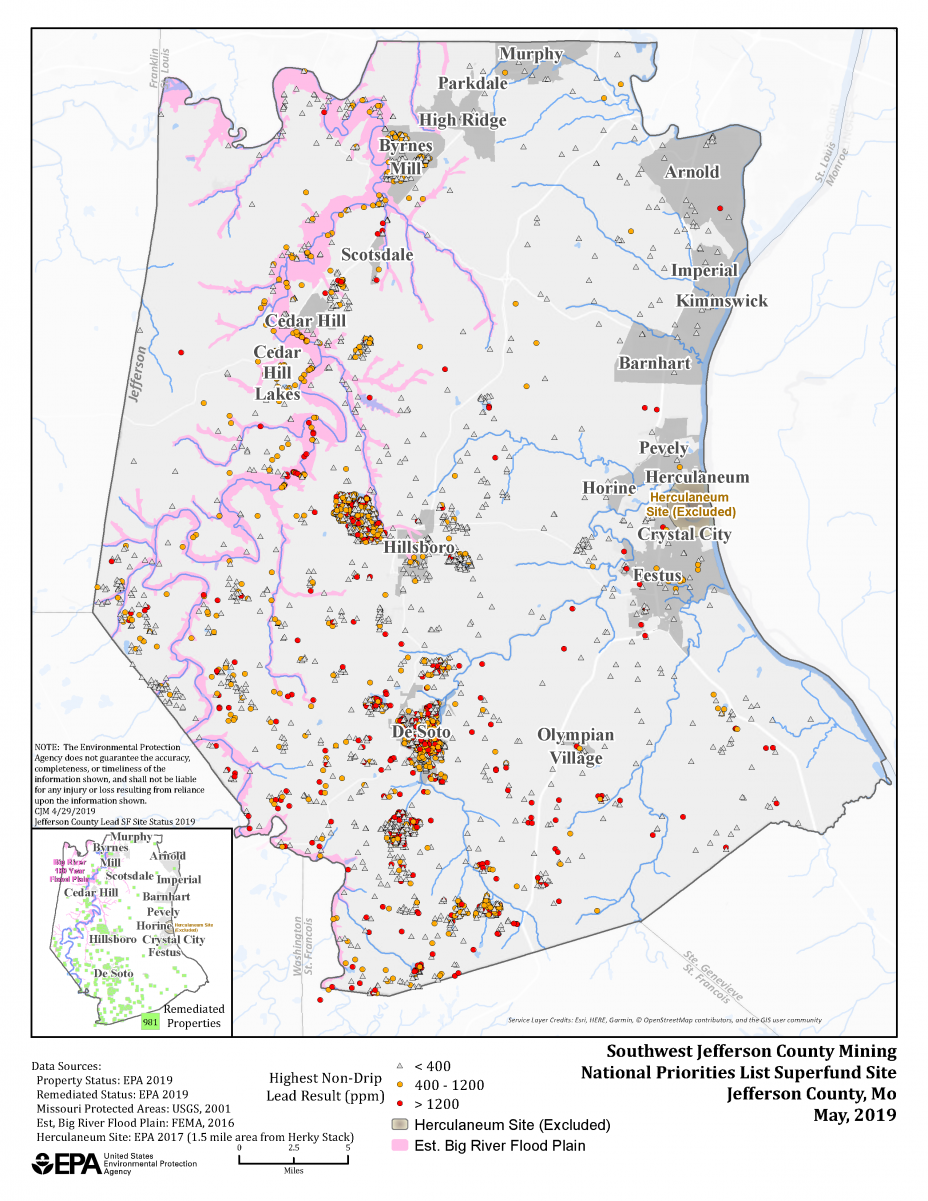Southwest Jefferson County Mining National Priority List (NPL) Superfund Site, Jefferson County, Missouri - Fact Sheet, May 2019
Lead Testing and Cleanup Opportunity
Residential Soils and Private Drinking Water Wells
Remedial Actions at the Site
OVERVIEW
 The U.S. Environmental Protection Agency (EPA) Region 7 is remediating (cleaning up) lead-contaminated soil in residential yards within the Southwest Jefferson County Mining National Priorities List (NPL) Superfund Site. (See "Properties sampled" map at right.) Lead is a toxic metal that is harmful if inhaled or swallowed; it is the main contaminant of concern. Lead is classified by EPA as a probable human carcinogen and is a cumulative toxicant. Lead exposure can pose serious health risks, particularly for young children 7 years old and younger, pregnant women, and nursing mothers. Pregnant women and nursing mothers should avoid exposure to lead to protect their children. (See additional information and larger site map below.)
The U.S. Environmental Protection Agency (EPA) Region 7 is remediating (cleaning up) lead-contaminated soil in residential yards within the Southwest Jefferson County Mining National Priorities List (NPL) Superfund Site. (See "Properties sampled" map at right.) Lead is a toxic metal that is harmful if inhaled or swallowed; it is the main contaminant of concern. Lead is classified by EPA as a probable human carcinogen and is a cumulative toxicant. Lead exposure can pose serious health risks, particularly for young children 7 years old and younger, pregnant women, and nursing mothers. Pregnant women and nursing mothers should avoid exposure to lead to protect their children. (See additional information and larger site map below.)
EPA is asking residential property owners for access to conduct the free lead contamination testing. If your property has been tested and is eligible for remediation [400 parts per million (ppm) lead or higher], EPA’s contractor will perform the cleanup for free. Residential properties also include child high-use areas (childcare facilities, parks and playgrounds). To schedule your property or private well for free testing, please contact your EPA representative listed on Page 2. Sampling and cleanup is performed at no cost to property owners.
BACKGROUND AND SITE UPDATE
The Southwest Jefferson County Mining NPL Site is part of the Old Lead Belt in southeastern Missouri, which was one of the world’s largest lead mining districts, where mining began in the early 1700s and produced more than 9 million tons of lead. Extensive lead mining, milling and smelting activities contaminated soil, sediment, surface water, and groundwater with elevated levels of heavy metals, primarily lead, prompting the need for state and EPA involvement. Some county residents have unknowingly purchased lead-contaminated soil and/or gravel for use in yards, driveways, parking areas, and playgrounds.
To protect human health and the environment from the dangers of lead at the site, EPA has sampled (tested) over 4,595 residential yards for lead contamination, and over 980 yards have been cleaned up since work began in 2007. Many more properties are eligible for remediation. EPA aims to sample as many residential and child high-use areas as possible for potential lead contamination.
In addition, approximately 1,252 private drinking water wells have been tested for elevated lead levels in the groundwater. EPA has provided bottled water to prevent residents from drinking elevated levels of lead in their well water.
LEAD HEALTH RISKS AND TESTING FOR CHILDREN
Lead exposure can cause a range of adverse health effects, including behavioral disorders, learning disabilities and seizures, putting young children at the greatest risk because their brains and nervous systems are still developing. Children 7 years old and younger are most at risk from developing health effects from exposure to lead. It is important that children in this age range be tested annually, because lead-poisoned children do not always look or act sick. The only way to know if your child has elevated blood lead levels is to have his or her blood tested. Your doctor can do a simple blood test to check your child, or you, for lead exposure. Talk to your pediatrician, general physician, or local health agency about testing your child.
To arrange for lead screening of your children, please contact one of the Jefferson County Health Department locations in these cities: Hillsboro - 405 Main Street; Arnold - 1818 Lonedell Road; High Ridge - 5684 Missouri PP. Contact them by phone at 636-797-3737.
EPA CONTACT INFORMATION
To arrange for free testing of your residential yard and/or private drinking water well, contact EPA at:
Lenexa, KS 66219
Lenexa, KS 66219
FOR ADDITIONAL LEAD AND SITE INFORMATION
- Visit the Southwest Jefferson County Mining Site page
- EPA posts Fact Sheets for Missouri cleanup sites online
- CDC’s ATSDR Lead ToxFAQs™
- CDC’s Lead page
- EPA's Lead pages: www.epa.gov/lead and www.epa.gov/lead/learn-about-lead
- EPA’s Protect Your Family from Lead in Your Home
- EPA's Superfund Community Involvement page with technical assistance resources
HOW WILL EPA CLEAN UP MY PROPERTY?
If your residential property qualifies for cleanup (also known as remediation), EPA will include an access agreement with a sampling results letter. By signing and returning the access agreement, owners are taking the first step in the process to allow the EPA contractor to clean up the affected areas of the property. This work is conducted at no cost to the property owner.
Step 1: The EPA contractor will schedule a time to meet with the property owner, review the affected areas of the yard, answer any questions, and address any concerns.
Step 2: The EPA contractor will ask the owner to sign a checklist and give them final permission to start the work. Once utilities are located, the cleanup may begin within a few weeks, weather permitting. The contractor’s checklist of items to discuss will include the location of private utilities installed by the homeowner at the property and determining the best way to move equipment in and out. It is the sole responsibility of the contractor to have utilities marked and work around them as necessary. If the contractor damages utilities, they will repair the utilities at no cost to the property owner.
Step 3: The cleanup generally includes excavating up to one foot of soil from areas that qualify for cleanup, unless it is a garden. If a garden is still above the EPA “action level” at one foot of depth, it will be excavated to two feet.
Step 4: The EPA contractor will sample the base of excavation and, if the concentrations of lead are 1,200 ppm or greater, the contractor will place a highly visible barrier at that depth prior to backfilling. If the soil is disturbed in the future, the barrier will warn people that contaminated soil remains below the barrier.
Step 5: The EPA contractor will then replace these areas with clean soil, return the grade to the original contours, and restore the lawn. Note: The contractor is only permitted to restore the property to its original condition and is required to repair or replace any items damaged during the cleanup process. They will assist with watering to establish grass, but the property owner is responsible for maintaining the growing lawn.
Step 6: Once the restoration work is complete, the EPA contractor will request a final meeting with the property owner to review the work and sign a final checklist to confirm satisfactory completion.

